
None of us will likely see Venus pass, like a moving beauty spot, across the face of the sun again.
From the U.S. to South Korea, people around the world turned their attention to the daytime sky on Tuesday and early Wednesday in Asia to make sure they caught the rare sight of the transit of Venus. The next one won't be for another 105 years.
``If you can see the mole on Cindy Crawford's face, you can see Venus,'' Van Webster, a member of the Los Angeles Astronomical Society, told anyone who stopped by his telescope for a peek on Mount Hollywood.
For astronomers, the transit wasn't just a rare planetary spectacle. It was also one of those events they hoped would spark curiosity about the universe and our place in it.
Sul Ah Chim, a researcher at the Korea Astronomy and Space Science Institute in South Korea, said he hoped people see life from a larger perspective, and ``not get caught up in their small, everyday problems.''
``When you think about it from the context of the universe, 105 years is a very short period of time and the Earth is only a small, pale blue spot,'' he said.
While astronomers used the latest technology to document the transit, American astronaut Don Pettit aboard the International Space Station was planning to take photos of the event and post them online.
Meanwhile, terrestrial stargazers were warned to only look at the celestial event with a properly filtered telescope or cardboard eclipse glasses. If the sun is viewed directly, permanent eye damage could result.
In Los Angeles, throngs jammed Mount Hollywood where the Griffith Observatory rolled out the red carpet for Venus. The last time the city witnessed a Venus transit was 130 years ago in 1882. A 2004 transit was not visible from the western U.S.
Telescopes with special filters were set up next to the lawn and people took turns peering at the sun before and during the transit. Astronomers and volunteers lectured about the rarity of a Venus pass to anyone who would listen.
Minutes before Venus first touched the outer edge of the sun, Sousa's ``Transit Of Venus March'' blared through. The crowd turned their attention skyward. For nearly 18 minutes, Venus appeared as a black spot.
Jamie Jetton took the day off from work to bring her two nephews, 6 and 11, visiting from Arizona to the observatory. Sporting eclipse glasses, it took a little while before they spotted Venus.
``I'm still having fun. It's an experience. It's something we'll talk about for the rest of our lives,'' she said.
Bo Tan, a 32-year-old software engineer took a half day off from work and went with his co-workers to the observatory. He admitted he wasn't an astronomy buff but could not miss this opportunity.
He pointed his eclipse glasses at the sun and steadied his Nikon camera behind it to snap pictures.
``It makes you feel like a small speck in the universe,'' he said.
<관련 한글 기사>
놓쳤으면 이제 105년간 못 볼 '금성일식'!
금성이 태양을 가로지르는 우주쇼가 6일 오전 7 시 9분 38초부터 시작돼 오후 1시 49분 35초까지 약 6시간 40분간 우리나라 전역에서 펼쳐졌다.
금성의 태양면 통과를 이번에 놓치면 2117년 12월 10일, 2125년 12월 8일에나 볼 수 있다. 우리 세대에서는 사실상 마지막 관측인 셈이다.
금성은 태양보다 32분의 1정도로 작아, 까만 점이 태양의 밝은 면을 천천히 지나는 모습으로 나타났다. 이번 통과는 금성이 태양의 왼쪽 상단부터 오른쪽 상단을 향해 대각선으로 비스듬히 내려가듯 진행됐다.
금성의 태양면 통과 현상은 지구-금성-태양이 일직선상에 놓이고, 지구의 공전 궤도와 금성의 공전궤도 간에 교차점이 생길 때만 발생한다. 지구-금성-태양이 일렬 로 늘어서는 1.6년마다가 아닌, 8년-105.5년-8년-121.5년 주기를 갖는 이유다.
지구에서 태양면 통과 현상이 관측되는 행성은 금성과 수성 뿐이다.
수성의 태양면 통과는 1631년 프랑스의 천문학자 피에르 가센디가 최초로 관측했다. 가센디는 한달 뒤 금성의 태양면 통과를 관측할 기회가 있었으나 프랑스 지역 에선 이 현상이 태양이 뜨기 50분 전에 끝나 실패했다.
금성의 태양면 통과를 처음 관측한 영광은 1639년 영국의 아마추어 천문학자 제레니 호럭과 그의 친구 윌리엄 크랩트리에게 돌아갔다.
미국의 작곡가 존 필립 소사는 1882년 이 우주 현상을 기념하기 위해 '금성의 태양면 통과 행진곡(Transit of Venus March)'이란 관악곡을 썼다. 그는 미국 국 인 '성조기여 영원하라'도 작곡했다.
이번 통과 현상은 태양을 잘 볼 수 있는 트인 공간 어디에서라도 볼 수 있었다. 맨눈으로 직접 보면 실명할 수 있으므로 태양필터, 용접용 유리 등의 보호장비가 필요한 만큼 많은 관측자들이 전국 각지에서 열리는 행사장을 찾았다.








![[Graphic News] More Koreans say they plan long-distance trips this year](http://res.heraldm.com/phpwas/restmb_idxmake.php?idx=644&simg=/content/image/2024/04/17/20240417050828_0.gif&u=)
![[KH Explains] Hyundai's full hybrid edge to pay off amid slow transition to pure EVs](http://res.heraldm.com/phpwas/restmb_idxmake.php?idx=644&simg=/content/image/2024/04/18/20240418050645_0.jpg&u=20240419100350)





![[From the Scene] Monks, Buddhists hail return of remains of Buddhas](http://res.heraldm.com/phpwas/restmb_idxmake.php?idx=652&simg=/content/image/2024/04/19/20240419050617_0.jpg&u=20240419175937)

![[KH Explains] Hyundai's full hybrid edge to pay off amid slow transition to pure EVs](http://res.heraldm.com/phpwas/restmb_idxmake.php?idx=652&simg=/content/image/2024/04/18/20240418050645_0.jpg&u=20240419100350)

![[Today’s K-pop] Illit drops debut single remix](http://res.heraldm.com/phpwas/restmb_idxmake.php?idx=642&simg=/content/image/2024/04/19/20240419050612_0.jpg&u=)